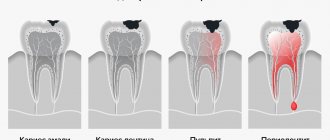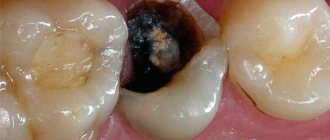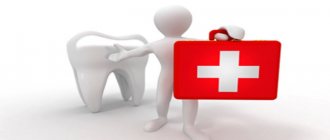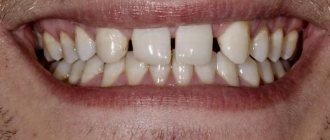Antique mold for modeling the surface of teeth. Yes, it is possible that, according to compulsory medical insurance, a crown will be made on this one.
From each of your salaries you deduct 5.1% for compulsory medical insurance. That's quite a lot. If your salary is 100,000 rubles, then every year you deduct 61,200 rubles. At this point, everyone begins to get nervous, realizing that a VHI policy with much better quality treatment will not be cheaper. In fact, you just need to understand that the tasks of these types of insurance are radically different. With your compulsory medical insurance contributions, you also pay salaries to surgeons and maintain hospitals where you can be taken if you are unlucky and a brick falls from the roof on your head. Pensioners, people with salaries in the minimum wage region, and children receive medical care with the same money. Hence the dramatic difference in quality and tasks. According to VHI, they can pull out a nail, but according to compulsory medical insurance, they can only bend it, so that it is convenient and does not reduce the quality of life.
You can also just come and pay yourself. This also makes sense when we talk about procedures that are not covered by compulsory health insurance and voluntary health insurance. For example, obesity treatment is almost never covered by insurance, even though it plays an important role in the patient's health.
Dentistry can also be paid for from three sources:
- Pay yourself. You will receive as good a level of service as you can afford to pay for. This is the only way to usually pay for the most expensive manipulations and high-quality designs.
- Go for compulsory medical insurance. It's not all bad, you can get basic medical care, but in general it all comes down to the cheapest false teeth so that you can chew at least somehow. It may be suitable for simple things.
- Go to VHI. Coverage depends on the policy and most often does not provide the opportunity to get high-quality prosthetics or use expensive equipment and materials. But this option will cover the prevention and treatment of initial forms of caries well.
I’ll tell you now what exactly is worth treating under what insurance.
Compulsory medical insurance is a mass product
Features of compulsory medical insurance in general
- Prevents you from dying in case of an acute condition.
- Prevents you from becoming disabled due to the development of a serious illness.
- Covers single, particularly expensive surgeries such as neurosurgery, joint replacement or coronary artery bypass grafting.
- Provides an acceptable level of health to the maximum number of citizens.
- Provides free expensive medications to certain groups: growth hormone for children, insulin for diabetics, monoclonal antibodies for people with rheumatism.
Pros of compulsory medical insurance
Let's just estimate whether medicine is as accessible as we think. Let's take severe forms of rheumatism, for which a council of doctors found the use of glucocorticoid hormones ineffective. Accordingly, it is necessary to provide the patient with lifelong therapy with monoclonal antibodies like Sarilumab. They allow you to more precisely turn off inflammatory reactions by binding specific interleukins. The drug is required to be administered at a dose of 200 mg every two weeks, depending on the clinical situation. A quick search shows that the average cost of such a dose starts at 73,000 rubles. That is approximately 1,750,000 per year. For life. And yes, such drugs are covered from the compulsory medical insurance budget if they are vital, despite limited quotas. It’s difficult to afford this at your own expense, even with a very good salary.
Inpatient treatment is also not a gift. The average cost of treatment in Moscow, according to the Federal Compulsory Medical Insurance Fund:
- Stroke - 196–477.6 thousand rubles.
- Heart attack - 169.3–319.1 thousand rubles.
- COVID-19—200–205.2 thousand rubles.
And there are all sorts of orphan diseases, insulins and hormones. This is unaffordable for most people. Voluntary health insurance does not insure against this either; they are either not interested in such risks, or the cost of insurance will be simply prohibitive. In addition, the state system is required to maintain a developed network of hospitals designed for large volumes. If the current flow is transferred to private clinics and voluntary health insurance, then they will most likely become ineffective as well.
Cons of compulsory medical insurance
Compulsory medical insurance is a conveyor belt that operates with conditional morbidity figures per 100,000 population. His task is, first of all, to prevent you from dying or getting some kind of severe disability, after which you will not be able to work and pay taxes. His tasks do not include comfortable anesthesia, aesthetic incisions, pleasant music in the halls and the absence of queues.
That is why it is so uncomfortable in the case of simple and inexpensive diseases. In this case, it is much more pleasant to use VHI or even pay for the appointment yourself.
What you immediately want to optimize
Of course, it’s easy to talk from the position of a private medicine doctor, but judging by personal rare visits and reviews of colleagues working on compulsory medical insurance in clinics, there is a lot that I want to optimize.
Most of all I want to relieve the doctor of dull routine work. For some reason, in private clinics everyone understands that a doctor is a valuable working unit, he has studied for many years and must perform the most difficult work. Therefore, in a private clinic, the doctor only deals with treatment, and all the paperwork is completed by the registrars.
In a clinic, most often the doctor is busy with a bunch of non-core tasks that do not require any education other than 9 years of school. For example, writing prescriptions. If a patient is entitled to receive one pen of insulin every month for free, then a prescription can be generated automatically and sent out through State Services. All. Once every three months there is a follow-up examination, during which the doctor does not have to do the dull work of copying the previous prescription and filling out paperwork.
Almost 90% of the work can simply be replaced with simple three-line programs, several recorders and an expert system that will solve simple cases.
Compulsory medical insurance in dentistry
Compulsory medical insurance in dentistry is a completely different story. Even during the USSR, the budget covered only the most necessary things, and the rest was paid by the patient if necessary. On the one hand, compulsory medical insurance conditionally guarantees that you will not suffer from acute toothache. On the other hand, you can simply pull out this tooth and thereby solve the problem. And it doesn’t matter that with the use of microscopes, expensive equipment and a lot of time, the tooth could be saved. This is not squeezed into the conditional 217 rubles 37 kopecks allocated to solve your problem. Therefore, you must immediately understand that compulsory medical insurance dentistry in its pure form will make it so that you don’t get sick and will provide some chewing with a scary acrylic prosthesis.
Surgery
Carpule syringe.
The ring is needed so that you can pull it towards yourself and make sure that it does not fall into the vessel. Anesthetic in a special capsule. There will be no such thing under compulsory medical insurance . For example, I really remember budget dental surgery while studying at the university. No more than half an hour of time is allocated per patient. During this period, you need to have time not only to remove the tooth itself, but also to talk with the patient, conduct an examination, and fill out a bunch of papers and cards. And yes, full anesthesia often occurs only after 15 minutes. Therefore, a conveyor belt was organized, when the patient was briefly listened to, looked at a photograph of the tooth, anesthesia was administered in a chair and quickly sent into the corridor. The next patient was placed on the chair and anesthesia was given to him. About three minutes per person. When the first patient became anesthetized in the hallway, he was brought back, the tooth was quickly removed, ice was applied, and he was sent home. This completes the OMS removal. Naturally, the default is a thick needle of a regular syringe and lidocaine, which often causes allergic reactions and does not work very well. If the patient paid extra, then the syringe was already carpule and the more effective articaine with epinephrine was administered.
According to compulsory medical insurance, you cannot even count on good extraction planning, gentle instruments and a leisurely doctor who will remove the tooth from the socket without damaging the bone structures. In addition to gentle removal in the normal paid version, you perform one-step implantation, which minimizes future bone loss due to missing teeth.
Therapy
In therapeutic dentistry, things are not much better. An absolutely paltry amount of around 150-200 rubles is allocated for an appointment, which does not even cover normal basic Russian-made consumables. Now we have somehow moved away from the terrible zinc-phosphate and zinc-eugenol cements, which fell out safely after almost a month. But the alternative made from cheap chemical composites is also not much better. Chemical composite is a paste-to-paste material. That is, you first mix two components on a special notepad or glass, and then within a couple of minutes you must heroically fashion a filling. After a few minutes, the material will harden, and the excess will only have to be cut off. Usually a doctor on the job, of course, somehow adapts, but most often it turns out scary and non-functional. You can forget about accurate modeling of tooth anatomy. It doesn’t fall out and that’s okay. It reminds me very much of visiting a phantom class, where doctors of various specialties are trained. I had some time and tried to remove the appendix on an endoscopic surgery simulator. The sensations are incredibly cool, but in the end it all resulted in a competition with a colleague for speed. After 10 attempts, I eventually won, removing the virtual appendix in 2.5 minutes, with only three cauterized liver bleeds. Unfortunately, there is a feeling that the eternal overload of doctors and the strict time frames of compulsory medical insurance ultimately lead to something similar in dentistry.
Canal treatment is also a different story. A normal canal most often resembles the root system of a plant. The main channel is quite wide, but it has a bunch of very thin side branches that you can't get into directly with a tool. Normally, you should pour 40 syringes of warm sodium hypochlorite into each channel, covering yourself with a vacuum cleaner and rubber dam. And then rinse everything with a sterile saline solution. Then it is often necessary to put calcium hydroxide in each channel. This is a very long time. Therefore, the standard option according to compulsory medical insurance is to mummify the remains of soft tissue in the tooth canal. You don't care if there are side branches there. You simply relieve the pain by killing the nerve tissue and hope that endodontic treatment alone will suffice. As you can imagine, this often ends in chronic infection in the form of periodontitis and a cyst at the root apex.
For example, we later see such interradicular cysts when removing a decayed tooth. Previously, the terrible resorcinol-formaldehyde method was still popular. When soaked in this hellish mixture, the entire infection was actually killed along with the soft tissues of the tooth. Endodontics is not needed, everyone is rejoicing. However, the tooth became red-violet in color and turned into a brittle glassy mass. It was pointless to re-treat anything; the channels simply became inaccessible. When removed, such a tooth crumbled and fell apart.
Orthopedics
Samson device for broaching sleeves for stamped crowns
Orthopedic dentistry is also covered at the very minimum level and with the cheapest materials. Instead of 3D scanners and milling cutters, there will be the cheapest alginate mass and a tortured technician who casts models from semi-structural alabaster without any automatic mixers and vacuum degassers that remove air bubbles.
Standard crowns according to compulsory medical insurance are stamped from cobalt-chromium steel. They are made from standard sleeves, which are stretched on a hefty Samson machine to the required diameter. Then the technician takes the dies and hammers them into the sleeve with a hammer. It hammers it in with precision, giving it shape. Still, such crowns are better than a huge filling that will fall apart along with the tooth in a few months.
Dentistry. Where is it better to treat teeth: in paid clinics or government ones?
For many years, public dental clinics remained a place where people went with great caution and only when it was necessary to have teeth removed.
Not everyone thinks about resorting to treatment as soon as the first symptoms begin; most people wait until the last minute, when there is nothing left to “save” and the only way to get rid of the aching pain is by removing a tooth. Why don't people go to get their teeth treated when they first start to bother them? After all, in public dentistry, treatment is provided free of charge; you just need to take a coupon and just come for an appointment. It's not just about the medical equipment, which looks more like instruments of torture, but also about the quality of the material. Sometimes one filling has to be changed several times a year! In addition, removing, treating, and filling teeth is not a pleasant pleasure.
Free health care facilities are funded by the state, but not to a sufficient extent. And this, of course, is reflected in the quality of the equipment. Therefore, the emergence of paid dental clinics is due to the fact that people were willing to pay for quality care rather than experience terrible pain in public dentistry.
People welcomed the emergence of private dental clinics. Although the owners of private dental offices also had a hard time. In view of the new transformations in the country's economy, it is not enough to be a first-class specialist in your industry; you also need to have knowledge of accounting and other nuances of doing business. Of course, all dentists want to perform their direct duties without being distracted by business concerns. But still, private clinics continue to open, because this is an excellent opportunity to establish yourself as a professional in your field and work not for the state, but for yourself.
Today the situation is different. Specialists do what they love, and clinic managers may not understand anything about dentistry; it is enough for them that they know how to become an entrepreneur. It turns out that everyone benefits: dentists, clinic owners and patients, who can now be at least a little confident in the effectiveness of the services provided.
Despite this, there are a number of unsolved problems in both paid and public dental clinics.
Disadvantages of free dentistry:
1. Low quality of service.
The demand for dental treatment is very high. People constantly need the help of dentists. And the technologies used for treatment are outdated.
2. Methods are used that are harmful to the health of patients.
For example, stamped crowns. It is best to use cast crowns. There is a minimal gap between them and the tooth.
Problems of private dentistry:
1. Saving on necessary costs.
For example, they save on consumables, a change of clothes, proper nutrition and rest areas for dentists.
2. Incorrect organization of medical work.
Many paid dentistry work from 9.00-21.00. This, on the one hand, is a violation of labor legislation, according to which the working day should not exceed 33 hours and be less than 42 hours a week, and on the other hand, the dentist’s severe overwork affects the quality of his work and the risk of medical error is high.
3. The clinic’s warranty obligations rest entirely with the doctor.
If the dentist performed his work poorly, he bears financial responsibility for this. The amount of damage is recovered from the salary of the medical worker. The owner of a private clinic is exempt from additional costs for possible mistakes of his specialists.
Thus, it cannot be said with certainty that paid clinics are better than public ones. Both medical institutions still have work to do.
Of course, the appearance of the hospital is of great importance. It is much more pleasant to sit on a soft leather sofa and wait for a doctor’s invitation than to sit in line on a hard bench. It is much more pleasant to be in a cozy room with a beautiful design than in a place with shabby walls. But. There are plenty of low-qualified doctors everywhere. And this is the biggest disadvantage.
What's good about dentistry under compulsory medical insurance?
Prevention is great. If you are lucky and have a good clinic, then they can do basic hygienic cleaning and then cover it with inexpensive fluoride varnish. Fluoride varnish is disgusting, peels off with yellowish salty scabs, but is not useful. Simple caries, caught at an early stage under a cheap glass ionomer, is also much better than a tooth that has already fallen apart in a private clinic.
And compulsory medical insurance doctors often catch oncology during their examinations. It is very important. They can immediately refer you to oncology departments for a biopsy or treatment. It is usually not possible to get directly from a private clinic to a public oncologist. A friend of mine was diagnosed with lip cancer at an early stage. The tumor was excised and local radiation therapy was performed. In the end, everything is fine after almost ten years, only the scar remains.
So, in general, if phlegmon or an injury to the maxillofacial area happens to someone, it will be his fellow dentists who are compulsory medical insurance who will help him get back on his feet. A person will not be left without medical care, and at the end of treatment he will not be charged an astronomical bill of tens of thousands of dollars.
VHI in dentistry
VHI programs are very different. Dentistry is not only expensive for the state, but also for insurance companies. That is why this point is always described with a large number of exceptions and reservations. Most often this is a co-payment - you pay at least 10-15% of the total bill yourself.
VHI almost always includes prevention. Good prevention is cheaper than treatment, which is why insurance companies always include professional hygiene in their policies. Usually these are two professional cleanings per year with fluoridation, which are quite sufficient if the enamel is highly resistant, unless you have any critical periodontal problems or concomitant diabetes mellitus, for example. Professional procedures for periodontitis are often no longer covered by insurance in the required quantity and volume. Actually, VHI first of all tries to exclude chronic diseases that are expensive to treat and which will bring a guaranteed loss.
Standard inexpensive voluntary health insurance usually includes only uncomplicated caries. This is when there is a defect in the enamel and/or dentin, but nothing else is affected. Moreover, the defect is not very large.
If caries is complicated by pulpitis or periodontitis, then the insurance company most often immediately rolls out a huge list of restrictions, which most often come down only to eliminating acute pain to a minimum extent. Does not hurt? Great. Then for your money. Endodontics is allowed to a very minimal extent; aesthetic restorations, inlays and crowns after treatment are almost never included in insurance, since this is the most expensive part of the treatment.
However, sometimes there is VHI, which allows almost everything, including implantation, but it works differently. The insurance company's standard voluntary health insurance refers to risk contracts. That is, they are asking conditionally 15,000 for each of your employees per year and are obligated to treat them. It is understood that only a portion will be sick and the unspent surplus will be enough to ensure profit. If everyone gets sick en masse, then the insurance company is at a loss.
The second option for VHI is deposit. This is when you have a reputable oil company and you want to provide your top employees with the highest level of treatment. Naturally, you have no idea how to organize medical care and where to go with these problems. To do this, you come to the insurance company and say that here is a deposit for you, within the framework of which you will treat our employees. The insurance company does not bear any risks here and works as a management company in your home, organizing treatment. It was with such VHI that people came to us for full treatment with implantation and orthopedics. But this is rather an exception.
Insurance companies are very economical
Insurance companies often pay clinics on a deferred basis. At the same time, they do not pay for individual manipulations if it goes even slightly beyond the very narrow standards required. But this is still beneficial for clinics, although often an entire department is busy analyzing insurance claims.
It is very important for the clinic to bring a new client so that he feels that he will feel good there and that the doctors are professionals. Conventionally, the insurance company will cover two cleanings, and he will cover another one in addition to the coverage, if necessary.
At the same time, doctors always try to clarify in advance what will be included in the insurance and what will not, so that the patient does not get nervous. Unfortunately, this is not always possible, since during the treatment of caries it may turn out that it is no longer caries, but very much pulpitis. Then either the clinic has to perform some manipulations at a loss, or ask the patient to pay the required amount. There is another very important point: the insurance company may not pay for the level of treatment accepted in the clinic. For example, we believe that treatment without a rubber dam is simply unacceptable from the point of view of asepsis and isolation of the surgical field. This is important to reduce the risk of infection. The insurance company may not cover it. Doctors again have to either ask the patient to pay extra or worsen the quality of treatment in order to meet the requirements of the insurance company. Clinics that focus on accepting patients under VHI are ultimately forced to save significantly on the most complex and top-of-the-line things like microscopes.
Dental treatment according to VHI
Money
Voluntary health insurance (VHI) is a policy that gives the owner the right to receive medical services in private clinics, provided that the person has chosen the desired tariff from the insurance company and paid for it in advance. Of course, the most common way to get such a policy is as an additional bonus from your employer. In this case, the employer pays your contributions to both the compulsory medical insurance fund and the insurance company for VHI, and it already covers the costs of private clinics for your treatment. Each insurance company works with its own list of medical institutions, so you need to immediately clarify it by purchasing a policy yourself or receiving it at work. A voluntary health insurance policy can be basic or extended. For example, not all VHI policies include dental services, but they can be purchased in addition. The range of tariffs here is very large and depends on the insurance company. When a person with VHI has a toothache, he does not immediately go to the clinic. The first thing he does is call the insurance company and describe the symptoms to the doctor on duty. Based on the complaints, the dispatcher draws up an approximate picture of the disease and chooses which specialist to refer the patient to. If there are no special restrictions, the dispatcher takes into account your wishes - closer to home, closer to work, and so on. In order to receive further treatment under insurance after the initial appointment, you need to be given the correct diagnosis, and the doctor and the clinic have a financial interest in further caring for the patient. However, there is a nuance with VHI - sometimes the doctor is interested in selling services under VHI, and sometimes - private services of the clinic. The fact is that there are several types of insurance. The first type, attachment, involves a one-time visit, often with acute pain. They will not leave you to suffer, they will help you, but if the problem requires long-term treatment, insurance will not cover it. The second type of insurance is factual. In this type of insurance, treatment is agreed upon in advance with the clinic and the insurance company.
Naturally, it is more interesting to accept such patients, from whom we receive money every time
The attachment amounts, based on the VHI tariff, vary. On average, the clinic will receive from 800 rubles to 5 thousand rubles for a one-time patient.
Let’s say, according to the clinic’s price list, treating caries on average costs around 5 thousand rubles. And a patient, for example, has a thousand allocated for treatment under VHI. What interest do I have in treating his caries? Accordingly, I can lie to the patient, say, “You don’t just have caries here, you have caries with a large degree of tooth destruction and this is not an insured event, but you can treat it for a fee, I can even give you a discount since you came under the insurance program.” to still retain the patient
When coming for dental treatment under VHI, the patient cannot know for sure whether he will be treated completely free of charge, whether insurance will partially cover the treatment, or whether the doctor will try to impose additional services. It's always a gamble. And the insurance company can't verify who is right—they have to trust the doctor who examines you. Because the doctor is close to you, but the insurance manager is far away.
Quality
The patient may feel that VHI provides better quality treatment than compulsory medical insurance, since the employer or you personally contributed additional money to obtain insurance for yourself. It's a convenient idea, but it's often not true.
The VHI system does not bring much money to doctors, but it does bring money to clinic owners. Clinic owners do not want to invest in treatment under VHI and often purchase the cheapest materials for treatment through insurance.
According to Maria, it often turns out that in the same clinic, fillings that are provided for paid treatment are of better quality than fillings for those treated under VHI. It all depends on the greed of the particular owner of the clinic.
At one of my places of work, we had the same material for filling canals both for compulsory medical insurance and for payers. No expense was spared on materials. And at the same time, that material was of higher quality than when I worked in another private clinic and was treated under VHI and for a fee.
Some services, like taking pictures or brushing your teeth, can be safely done under VHI, because few consumables are needed, and it’s difficult for a specialist to save money on you and ruin something. In other cases, for quality treatment you need to be willing to pay extra.
If you want to receive high-quality treatment under the VHI system, you should prepare for financial investments, since insurance will not be able to cover the entire cost of the doctors’ work and materials. Moreover, it is better to immediately indicate your position to the doctor: say that you are interested in the best result and are ready to pay extra for this. This will make things easier for everyone.
Compulsory medical insurance, voluntary medical insurance or payment yourself?
It all depends on finances. If you are a hygiene maniac and regularly visit the dentist, then compulsory medical insurance will be quite good. Moreover, private clinics often also operate under compulsory medical insurance. It’s not worth doing something complicated under compulsory medical insurance - there are risks of getting a cheap irreversible solution, which you will then have to redo at your own expense.
If your employer provides you with voluntary health insurance, great. At a minimum, you should not neglect the prevention from the package. Basic things will be included there and in good quality. But be prepared for unexpected surcharges if you have very limited coverage.
If you want it perfect, with microscopes, rubber dams, 3D scanners and other high-tech, then VHI will not cover it. You will have to pay for such things out of your own pocket. Crowns, bridges and orthodontic braces will also have to be done at your own expense.
PS If you come to our clinics, then say that you are from Habr, there will be a 5% discount.
Dental treatment according to compulsory medical insurance
Money
Compulsory health insurance (CHI) is a system familiar to everyone since childhood, which allows anyone to receive free medical care in Russia.
But “free” here is very conditional. Every worker monthly gives the state 5.1% of his salary to the federal compulsory health insurance fund, which then distributes it. And through insurance companies, the money goes to medical organizations, compensating the costs of your treatment and the salaries of doctors in public clinics.
Due to the fact that every month you pay part of your salary, at the moment when you need to improve your health, with compulsory medical insurance you don’t have to think about money - you have already financed your treatment in advance. Or someone did it for you if you are not working. The illusion of freeness comes from the fact that you do not see this money, as well as your own pension contributions and income tax paid - the employer does this for you, but not from his own money, but from your money.
Quality
Under compulsory medical insurance, you can receive almost all dental services except prosthetics, implants, installation of mouth guards and braces.
Treatment of caries, pulpitis, cleaning, filling are also included in compulsory medical insurance. But there is a significant drawback to this treatment - reliable light fillings are not installed for free. You will have to pay extra for them and for high-quality pain relief. The good news is that, as a rule, municipal clinics in big cities always have them in stock.
There can be no good fillings according to compulsory medical insurance. We had chemical-curing fillings installed under the compulsory medical insurance program. This is the last century. Even if they paid me, I wouldn’t put such a filling on myself
According to expert Maria Matievskaya, it is possible to receive high-quality treatment under compulsory medical insurance, but you still need to prepare for certain financial investments. For example, go to treat caries for free, but agree with a doctor to install a high-quality light filling for an additional fee.
You can come under the compulsory medical insurance program and say directly: “I want to get a good filling, good treatment. What does that require?" You don't have to get treatment right away, but you can listen and find out what options the doctor suggests. First of all, I would recommend consulting and then making a decision
In addition, the compulsory health insurance system includes teeth brushing to a limited extent. You can count on tartar being removed from your teeth without affecting the spaces between your teeth. Often clinics simply do not have such technology. As for surgical dentistry, it makes sense to contact public clinics under the compulsory medical insurance program. This is due to the fact that doctors in private medical institutions that accept voluntary health insurance work part-time in several branches of dentistry. It turns out that if you need to see a specialist, it will be easier to find one in a state clinic, where there are more staff members and “generalists” are less common.
Compulsory medical insurance in private clinics
Yes, some private hospitals and clinics receive funding from the compulsory medical insurance fund, which means you can be treated there for free. You can find out which private medical center you can go to with your compulsory medical insurance policy on the website or by calling your regional compulsory insurance fund. Here are the sites of Moscow and St. Petersburg.
To contact a private clinic, you will need a compulsory medical insurance policy, a passport and SNILS. But be prepared to wait - there may be separate reception hours, separate queues, and a very limited list of services for you.
When does it make sense to go to a private clinic under compulsory medical insurance? For example, when tests, high-tech research (MRI, CT) or an operation covered by compulsory medical insurance are urgently needed.
You can also get dental care, but here you need to clarify in advance what kind of manipulations the private clinic is ready to perform with you.










